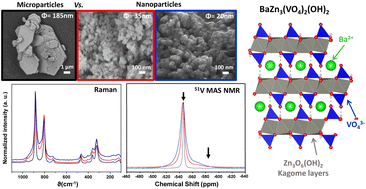Micro- and nanostructured layered-kagome zinc orthovanadate BaZn3(VO4)2(OH)2†
Abstract
Pure micro- and nanocrystalline powders of the layered-kagome zinc orthovanadate BaZn3(VO4)2(OH)2 have been successfully prepared and thoroughly characterised. Microstructured samples (BaZn3-MPs) have been produced by hydrothermal reaction using synthetic martyite Zn3V2O7(OH)2·2H2O as the starting reagent. Nanoparticles (NPs) with an average size of ≈ 60 nm (BaZn3-NPs-7h) or ≈ 50 nm (BaZn3-NPs-25min) have been obtained by using a coprecipitation method at ambient pressure, and by varying the stirring time. Rietveld refinements of X-ray diffraction data indicate that micro- and nanostructured BaZn3(VO4)2(OH)2 both crystallize in a R![[3 with combining macron]](https://www.rsc.org/images/entities/char_0033_0304.gif) m structure very similar to that of the known layered-kagome compound BaCo3(VO4)2(OH)2. Transmission electron microscopy observation of BaZn3-NPs-7h and BaZn3-NPs-25min reveals crystallized NPs with homogenous distributions of Ba, Zn, and V elements. FT-IR and Raman spectra show subtle differences between micro- and nanostructured samples which cannot be linked to any differences in the average crystal structures. The high resolution 51V MAS NMR spectrum of BaZn3-MPs shows a single isotropic line attributed to VO43− groups with C3v point group. The spectra of the nanostructured samples reveal the presence of a weak additional signal which decreases in intensity with increasing the NPs size, and which has been tentatively assigned to the presence at the surface of the NPs of a small amount of V5+ ions in a different chemical environment. Nanostructuring also impacts the optical properties of BaZn3(VO4)2(OH)2. The UV-vis absorption spectra of NPs exhibit an additional weak transition in the visible domain which is not observed for the microstructured sample.
m structure very similar to that of the known layered-kagome compound BaCo3(VO4)2(OH)2. Transmission electron microscopy observation of BaZn3-NPs-7h and BaZn3-NPs-25min reveals crystallized NPs with homogenous distributions of Ba, Zn, and V elements. FT-IR and Raman spectra show subtle differences between micro- and nanostructured samples which cannot be linked to any differences in the average crystal structures. The high resolution 51V MAS NMR spectrum of BaZn3-MPs shows a single isotropic line attributed to VO43− groups with C3v point group. The spectra of the nanostructured samples reveal the presence of a weak additional signal which decreases in intensity with increasing the NPs size, and which has been tentatively assigned to the presence at the surface of the NPs of a small amount of V5+ ions in a different chemical environment. Nanostructuring also impacts the optical properties of BaZn3(VO4)2(OH)2. The UV-vis absorption spectra of NPs exhibit an additional weak transition in the visible domain which is not observed for the microstructured sample.



 Please wait while we load your content...
Please wait while we load your content...